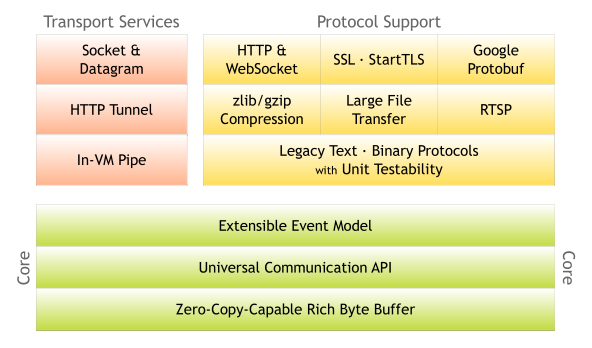Netty 异步的、事件驱动的网络应用程序框架和工具
Netty是由JBOSS提供的一个Java开源框架。Netty提供异步的、事件驱动的网络应用程序框架和工具,用以快速开发高性能、高可靠性的网络服务器和客户端程序。

netty---ByteBuf 注释翻译
/**
* ByteBuf是一个连续随机访问的bytes序列,是原始byte数组及ByteBuffer的顶层抽象。
*
* buffer创建:
* 推荐使用工具类Unpooled中的方法进行创建,也可以调用实现类的构造方法创建。
*
* 随机访问索引:
* 和通常的原始byte数组一样,ByteBuf使用基于0的索引,即第一个字节的索引为0,最后一个字节的索引为 capacity - 1,
*
* ByteBuf buffer = ...;
* for (int i = 0; i < buffer.capacity(); i ++) {
* byte b = buffer.getByte(i);
* System.out.println((char) b);
* }
*
* 连续访问索引:
* ByteBuf提供两个指针变量readerIndex、writerIndex分别用于读写操作,如下图表,两个变量将
* ByteBuf分割为三部分。
*
* +-------------------+------------------+------------------+
* | discardable bytes | readable bytes | writable bytes |
* | | (CONTENT) | |
* +-------------------+------------------+------------------+
* | | | |
* 0 <= readerIndex <= writerIndex <= capacity
*
* 可读取的字节(实际存储的内容):
* 这一部分是数据实际存储的位置,read和skip方法就是在这块数据上执行获取和跳过操作,同时read操
* 作会增加可读取字节数。如果read操作的参数是一个ByteBuf,并且未指定存储位置,则参数ByteBuf
* 的writeIndex 也会随着增长。
*
* 可读取的数据不足会抛出IndexOutOfBoundsException异常,新分配内存,包装或复制的buffer的
* readerIndex为0.
*
* 遍历buffer;
*
* ByteBuf buffer = ...;
* while (buffer.isReadable()) {
* System.out.println(buffer.readByte());
* }
*
* 可写入字节: *
* 这一部分是需要填充的未定义空间,write方法会从当前writeIndex位置写入数据并增加writeIndex值,
* 如果参数是ByteBuf且并未指定源索引,则参数ByteBuf的readerIndex也会随着增长。
*
* 如果当前可写空间不足,则抛出IndexOutOfBoundsException异常,新分配内存,包装或复制的buffer
* 的writerIndex为buffe的capacity容量。
* 随机填充
* ByteBuf buffer = ...;
* while (buffer.maxWritableBytes() >= 4) {
* buffer.writeInt(random.nextInt());
* }
*
* 可废弃字节:
* 这一部分为已经执行过读取操作的数据,初始空间为0,随着read操作的执行,最大增长至writeIndex值。
* 可废弃字节可以通过调用discardReadBytes()来丢弃,并重新标识为未使用。如下所示:
* discardReadBytes()执行之前:
*
* +-------------------+------------------+------------------+
* | discardable bytes | readable bytes | writable bytes |
* +-------------------+------------------+------------------+
* | | | |
* 0 <= readerIndex <= writerIndex <= capacity
*
*
* discardReadBytes()执行之后:
*
* +------------------+--------------------------------------+
* | readable bytes | writable bytes (got more space) |
* +------------------+--------------------------------------+
* | | |
* readerIndex (0) <= writerIndex (decreased) <= capacity
*
* 需要注意的是,通常情况下,discardReadBytes()操作无法保证buffer的可写数据。根据同的buffer
* 实现,大多数情况下,可写数据空间不会被移动,甚至会被完全不同的数据填充。
*
* 清除索引:
* clear()方法可以将buffer的readerIndex和writeIndex都置为0,但是并不清除buffer的数据,
* 另外需要注意是区分和ByteBuffer#clear()方法的不同。
* <h4>Clearing the buffer indexes</h4>
*
* <pre>
* clear()执行之前:
*
* +-------------------+------------------+------------------+
* | discardable bytes | readable bytes | writable bytes |
* +-------------------+------------------+------------------+
* | | | |
* 0 <= readerIndex <= writerIndex <= capacity
*
*
* clear()执行之后:
*
* +---------------------------------------------------------+
* | writable bytes (got more space) |
* +---------------------------------------------------------+
* | |
* 0 = readerIndex = writerIndex <= capacity
*
* 查询操作:
* 单字节查询可以使用 indexOf(int, int, byte) 方法,bytesBefore(int, int, byte)
* 方法对于处理null结尾的字符串会特别有用。
* 复杂查询可以使用 forEachByte(int, int, ByteProcessor) 方法(ByteProcessor 提供遍历字节集合机制, 方法中使用ByteProcessor的特定实现类)
*
* 标记和重置:
* ByteBuf中存在两种标记变量,分别用于存储readerIndex和writerIndex,可以通过调用reset()
* 方法来重置任意其一。除了没有readlimit变量,ByteBuf和InputStream具有相同的标记和和重置操作机制,
*
* 衍生buffer:
* 通过调用ByteBuf的以下方法可以创建一个已知buffer的镜像视图。
*
* #duplicate()
* #slice()
* #slice(int, int)
* #readSlice(int)
* #retainedDuplicate()
* #retainedSlice()
* #retainedSlice(int, int)
* #readRetainedSlice(int)
*
* buffer视图虽然和源buffer共享同一块儿内存,但是拥有完全独立的readerIndex,writeIndex和标记索引。
* 这和NIO buffer机制非常相似。
*
* 如果要获取一份全新的buffer备份,可以执行buffer的copy()方法。
*
* <h4>Non-retained and retained derived buffers</h4>
*
* duplicate()、slice(int, int)、readSlice(int)并未在新生成的衍生buffer执行retain()操作,因此
* 衍生buffer的引用计数没有增长。retainedDuplicate()、retainedSlice()、readRetainedSlice()
* 方法可以生成一个包含引用计数增长并且产生较少垃圾()的衍生buffer。
*
* JDK byte array转换
*
* Byte array
*
* 由byte数组(byte[])包装生成的ByteBuf,可以直接通过数据中的方法进行操作。
* 判断方法:hasArray()。
*
* NIO Buffers
* 如果一个ByteBuf可以被转换为NIO ByteBuffer,那么就可以通过nioBuffer的方法来操作ByteBuf。
* 判断方法:nioBufferCount()。
*
* 字符串输出:
* ByteBuf存在多种toString()方法,需要注意的是toString()方法并不是一个转换方法。
*
* I/O Streams
*
* 详见 缓冲输入输出流 ByteBufInputStream ByteBufOutputStream.
*/
项目地址:
https://github.com/windwant/windwant-service/tree/master/netty-service
https://github.com/windwant/spring-dubbo-service



